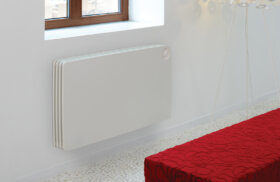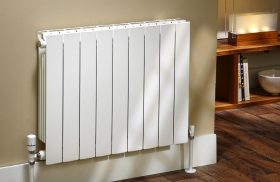There’s no doubt that vertical radiators are good-looking, but are they as efficient as horizontal radiators when it comes to heat output?
Vertical radiators vs horizontal radiators
According to the laws of physics, there is a difference between horizontal and vertical radiators, and a vertical radiator is slightly less efficient than a horizontal radiator. This is because radiators work on the principle that heat rises, so a radiator will draw cold air towards it at the lowest point, this air will heat up as it rises, and the hot air is then released back into the room. As a horizontal radiator is longer in width, it has the potential to draw in and heat more air. With vertical radiators, the air is fully heated before it reaches the top of the radiator. This means that only the lower sections of a vertical radiator will be working at maximum efficiency.
However, you’ve also got to take into consideration the fact that, with horizontal radiators, the heat could easily get blocked by furniture or curtains, reducing the radiator’s efficiency. The height of vertical radiators means they are less likely to be obstructed, in which case you’re looking at pretty much the same heat output.
Advantages of vertical radiators
- They make the most of limited space – Vertical radiators are great for small rooms and rooms that are awkwardly shaped, or rooms where there’s limited wall space on which to place radiators. As they’re tall and slim, they can be placed on narrow walls or between windows, making the most of the available space.
- They give you more interior design options – Furniture in front of a radiator will block the heat, so it’s important to keep the space in front of a radiator clear. With wall-mounted vertical radiators, there’s less space to keep clear, so you will have more space to place your furniture wherever you like around the room.
- They save space – For bedrooms and bathrooms, double up with a vertical Mirror radiator. This will mean you only need to take up one bit of wall space for heat and reflection.
- They’re creative – Vertical radiators are much more visible than horizontal ones, which is why radiator designers have created ones to be attractive enough to become an integral part of the room decor. You can even get vertical Art radiators, which will add beauty to the room at the same time as providing your visitors with a hot topic of conversation!
British Thermal Unit (BTU)
When it comes to heating your home, the orientation of your radiators is immaterial because it’s the heat output that matters.The British Thermal Unit (BTU) is the standard measurement of energy that has been widely used since the 19th century. One BTU is the amount of energy that’s needed to heat or cool one pound of water by one degree Fahrenheit at sea level. Once you’ve calculated the BTU requirement of a room, it’s immaterial whether you choose a vertical or horizontal radiator – as long as it meets the BTU requirement, your room will be just as warm and cosy!
Other considerations
If you are simply replacing a radiator, you will probably want to use the existing pipework rather than have the cost and disruption of hiring a plumber to make changes. If this is the case, then you are limited to radiator models that will fit the current plumbing, but it is a quicker way of installing a new radiator and costs a lot less. However, making the best use of the space may be worth changing the plumbing for, especially if you want to install a beautiful vertical radiator that will bring life to your room.
Visit one of our radiator showrooms to see our wide range of vertical and horizontal designer radiators and talk to one of our experts who will discuss your needs and calculate your BTU requirement in order to make sure you buy the right radiator for the room.





